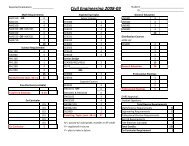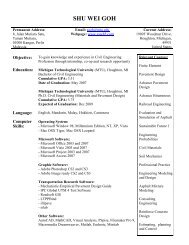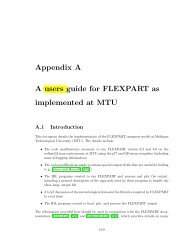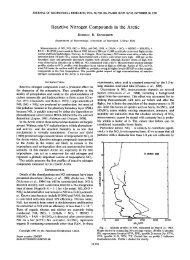Evaluation of Septic Tank and Subsurface Wetland for
Evaluation of Septic Tank and Subsurface Wetland for
Evaluation of Septic Tank and Subsurface Wetland for
You also want an ePaper? Increase the reach of your titles
YUMPU automatically turns print PDFs into web optimized ePapers that Google loves.
to an elevated tank when the municipal supply was not in service. The US$4,821 <strong>for</strong> the<br />
solar powered pumping system was not included in Table 6-1. Community labor was<br />
utilized at both sites to different degrees. This prevented direct comparison <strong>of</strong> labor costs<br />
between the projects <strong>and</strong> prevented direct transfer <strong>of</strong> per unit cost <strong>for</strong> estimating the<br />
expense <strong>of</strong> future projects. However, the available figures may be valuable <strong>for</strong> general<br />
knowledge <strong>and</strong> perspective.<br />
The per capital water usage <strong>of</strong> 1.3 L/p-d at Pisgah versus the 48.3 L/p-d water usage at<br />
Retrieve illustrates the difficulty in predicting the appropriate design flow rate <strong>for</strong> new<br />
sanitation systems. Recall that both <strong>of</strong> these schools had pit latrines be<strong>for</strong>e conversion to<br />
the flush toilet systems. Both sanitation systems were sized based on reported school<br />
populations <strong>and</strong> the same estimate <strong>for</strong> per capita water use. It should also be noted that<br />
the Retrieve system was designed <strong>for</strong> approximately twice the number <strong>of</strong> students than<br />
were attending during the evaluation.<br />
Because <strong>of</strong> the variation in per capita water use, dollar per liter <strong>of</strong> wastewater treated is<br />
not a useful cost metric. A more helpful capital cost comparison is dollar per liter <strong>of</strong><br />
design capacity. Dividing the Pisgah sanitation system construction cost <strong>of</strong> US$ 13,396<br />
by the 2,580 liters/day design capacity gives US$ 5.19 per liter per day. Dividing the<br />
Retrieve sanitation system construction cost <strong>of</strong> US$ 8,699 by the 1,290-liters/day design<br />
capacity gives US$ 6.74 per liter per day. These costs may be valuable <strong>for</strong> projecting the<br />
capital cost <strong>of</strong> future designs.<br />
Operating Costs<br />
The operation cost is expected to be low <strong>for</strong> any sanitation system such as that at Pisgah<br />
which uses rainwater harvesting <strong>for</strong> water supply <strong>and</strong> gravity instead <strong>of</strong> electricity <strong>for</strong> all<br />
water flow. The Retrieve system solar panels will not require utility payments although<br />
upkeep <strong>of</strong> an electric pump does increase future costs.<br />
53








